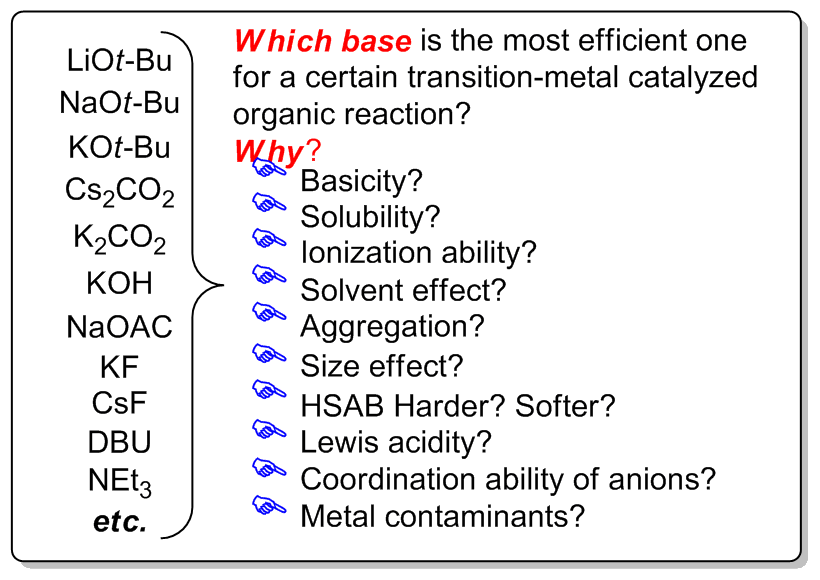《化学学报》发表本组综述文章“碱在过渡金属催化的有机化学反应中的作用”
碱在过渡金属催化的有机化学反应中的作用
欧阳昆冰 席振峰*
化学学报 DOI: 10.6023/A12110984
![]()

碱,包括无机碱和有机碱,在过渡金属催化的有机反应中发挥着重要作用。本文概括地介绍和讨论相关文献中碱的作用机制。碱的作用与许多因素有关,包括:碱性、溶解度、电离度、溶剂、聚集度、金属离子大小、金属离子Lewis酸性、金属离子的“软硬”度、阴离子的大小、阴离子的配位作用等。碱可用于攫取质子、中和反应体系中的酸、活化催化剂、促进催化剂再生等;碱中金属阳离子的作用主要集中在其对碱在有机溶剂中溶解度的影响和与底物或溶剂间相互作用力的强弱上;碱中阴离子的作用主要表现在离子与金属的配位方式和稳定性上;有机碱和无机碱的主要区别体现在溶解度和空间位阻的不同上。另外,商品碱中极少量的过渡金属杂质也有可能对反应产生影响。
Roles of Bases in Transition-Metal Catalyzed Organic Reactions
Kunbing Ouyang, Zhenfeng Xi*
Acta Chim. Sinica 2013, DOI: 10.6023/A12110984
Bases, either organic bases or inorganic ones, are very often added in transition-metal catalyzed organic reactions to promote the catalytic reaction efficiency and increase the yields of products. As a common practice for most published papers, a reaction condition screening table is given, listing a number of bases and the respective yield of products. However, no discussion or a little in some cases is provided on why one base works well to give a high yield formation of the product, but other bases afford no or low yields of the product. Furthermore, in many cases a certain base works well for one reaction but may not work for another. Indeed, for a complicated reaction mixture containing several different components, it is very difficult to analyze and understand the roles of certain bases. Yet there are sporadic discussions and rationalization on the roles of bases in the literature. The role of bases has been reported to be straightforward in some cases, for examples, to abstract protons or to neutralize acids in the reaction system, but very complicated in many other cases. The roles of bases may be affected by several factors, including basicity, solubility, ionization ability, solvent, aggregation state, the size of the metal cations, Lewis acidity of the metal cations, the HSAB theory, the size of the counter anions; the coordination ability of the counter anions, etc. In addition to abstract protons or to neutralize acids in the reaction system, a base may activate the catalysts and facilitate the regeneration of reactive catalytic species. The roles of the metal cation in a base may mainly influence the solubility of the base in organic solvents, or interact with substrates or solvents. The roles of the counter anion in a base may mainly contribute to the coordination with a metal center and subsequent stabilize the complex. The major differences between inorganic bases and organic bases include their solubility and bulkiness. Metal contaminants in bases may also have innegligible effect on the reactions, since in many cases a large excess amount of bases are added. This review is written based on the limited knowledge, focusing on commonly used inorganic bases such as LiOt-Bu, NaOt-Bu, KOt-Bu, LiOAc, NaOAc, KOAc, LiOH, NaOH, KOH, Li2CO3, Na2CO3, K2CO3, Cs2CO3, KF, CsF and organic bases such as DBU and Et3N.
